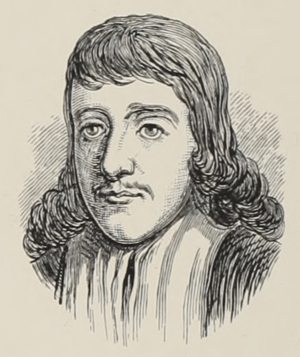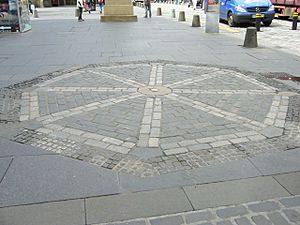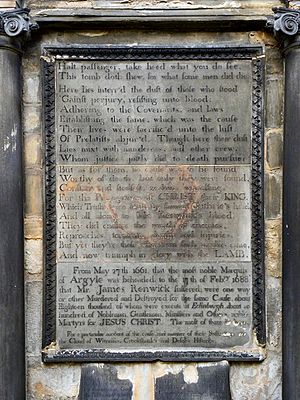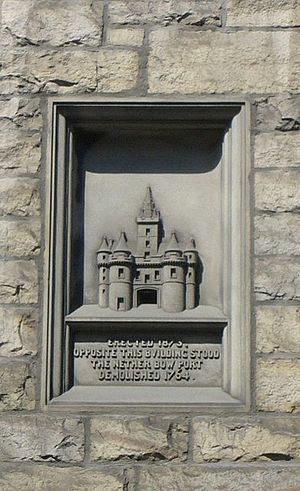James Guthrie (minister) facts for kids
Quick facts for kids James Guthrie |
|
|---|---|
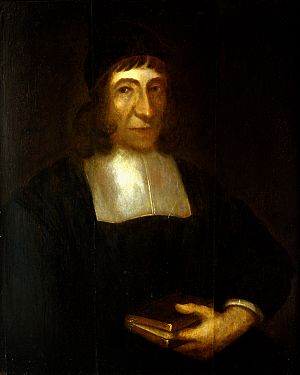
James Guthrie (unknown artist) The Stirling Smith Art Gallery & Museum
|
|
| Church | Lauder, Stirling (Church of the Holy Rude) |
| Predecessor | Henry Guthrie |
| Successor | Henry Guthrie |
| Orders | |
| Ordination | Lauder (1642) |
| Personal details | |
| Died | 1661 Grassmarket, Edinburgh |
| Denomination | Christian |
| Spouse | Jane (imprisoned in Shetland) |
| Children | two: William, Sophia |
| Alma mater | University of St Andrews |
James Guthrie (born around 1612 – died 1 June 1661) was an important Scottish Presbyterian minister. He was known for his strong beliefs and for standing up for what he thought was right. Even Oliver Cromwell, a powerful leader at the time, called him "the short man who would not bow." James Guthrie was a key figure during a time of big changes in Scotland. He was eventually put on trial and hanged in Edinburgh because of his strong views.
Contents
Early Life and Education
James Guthrie was born around 1612 in Forfarshire, Scotland. He was the oldest son of the laird (landowner) of Guthrie. He went to St. Leonard's College at the University of St Andrews. There, he earned his Master of Arts degree and became a teacher of philosophy.
At first, James Guthrie followed the Episcopalian way of worship. This meant the church was led by bishops. However, in 1639, he met Samuel Rutherford, a professor who believed in the Presbyterian system. Under Rutherford's influence, Guthrie became a strong Presbyterian. This meant he believed the church should be led by elders, not bishops.
Minister in Lauder and Stirling
In 1642, James Guthrie became the minister of Lauder, a town in Berwickshire. He quickly became known for supporting the National Covenant. This was an agreement signed by many Scots to protect their Presbyterian faith and freedoms.
He was a member of the General Assembly, which was like the main meeting for the Scottish Church, from 1644 to 1651. In 1646, he was chosen to meet with King Charles I in Newcastle. The purpose was to encourage the King to accept Presbyterianism.
In 1649, James Guthrie preached to the Scottish Parliament. Later that year, he moved to Stirling and became a minister at the Church of the Holy Rude. He stayed there for ten years.
Political Challenges and Beliefs

During James Guthrie's time, Scotland faced many political and religious disagreements. These often involved the King, the Parliament, and the Church.
Engagers and Remonstrants
One big disagreement started in 1647. King Charles I was a prisoner at Carisbrooke Castle. He made a secret deal with some Scottish leaders. This deal, called the "Engagement," promised to establish Presbyterianism in England for three years if Scotland helped him.
However, many in the Scottish Church, including James Guthrie, strongly disagreed with this deal. They felt it didn't fully protect their faith. This led to two main groups:
- Engagers: Those who supported the King's deal.
- Remonstrants: Those who opposed the deal and wanted to stick strictly to the Covenants. James Guthrie was a leading Remonstrant.
Resolutioners and Protesters
Another split happened after the Scottish army was defeated by Oliver Cromwell at the Battle of Dunbar in 1650. Some people thought the defeat was a punishment from God for their sins. They wrote a document called the Western Remonstrance, which listed problems and called for change.
Others believed they needed more soldiers, even if it meant allowing people who weren't fully committed to the Covenants to join the army. This led to two new groups:
- Resolutioners: Those who wanted to relax the rules for joining the army.
- Protesters: Those who strongly opposed relaxing the rules, believing it went against their religious principles. James Guthrie was a key leader of the Protesters. He believed in keeping the Covenants strong in all parts of the kingdom.
Guthrie and his fellow minister, Mr. Bennett, preached against these relaxed rules. They were called to appear before the King's council. They told the King they respected his power in civil matters but not in church affairs.
James Guthrie also took a strong stand against General John Middleton. Guthrie believed Middleton was an enemy of the Covenant and even announced his excommunication (being removed from the church) from his pulpit. This action made Middleton angry and would later have serious consequences for Guthrie.
Trial and Execution
After King Charles II returned to power in 1660, the situation became very difficult for the Protesters. James Guthrie and nine others met in Edinburgh to write a letter to the King, reminding him of his promises. However, this meeting was seen as a challenge to the King's authority.
James Guthrie was arrested on 23 August 1660 and imprisoned in Edinburgh Castle. His pay was stopped. He was moved to different prisons before being brought to trial in Edinburgh.
On 20 February 1661, James Guthrie was accused of treason. The charges against him included:
- Writing the "Western Remonstrance."
- Writing a pamphlet called "The Causes of God's Wrath."
- Writing the "Humble Petition" to the King.
- Holding meetings without permission.
- Refusing to accept the King's authority in church matters.
- Using "treasonable expressions" in 1650 or 1651.
Guthrie defended himself bravely, arguing that his actions were based on his religious beliefs and the laws of God. He knew a lot about Scottish law, which surprised his lawyers.
Despite his strong defense, James Guthrie was found guilty. On 28 May, Parliament ordered him to be hanged. He was executed at the Mercat Cross in Edinburgh on 1 June 1661. His head was then placed on the Netherbow Port, a gate in the city wall, as a warning to others.
Before his execution, Guthrie gave a speech, explaining his beliefs and why he would not change them. He said he had chances to escape but refused, as fleeing might make him seem guilty. He was known for his strong support of Presbyterian ideas and was called "siccar foot," meaning "sure-footed" or firm in his beliefs.
Family Life
James Guthrie was married to Jane Ramsay, who outlived him. They had a son named William and a daughter named Sophia. Tragically, in 1666, his wife and daughter were banished to a lonely prison in Shetland. This was because they had a copy of a book about the sufferings of faithful ministers.
Legacy and Remembrance

James Guthrie was about 49 years old when he died. He is remembered as one of the first martyrs (people who die for their beliefs) of the Covenant. His name is honored on the "martyrs' monument" in Greyfriars Churchyard in Edinburgh. This monument remembers those who died for their faith.
In 1690, the Scottish Parliament officially reversed the decision that had found him guilty of treason. His skull, which had been on public display for about 28 years, was finally removed and buried by a student named Alexander Hamilton.
Works and Writings
James Guthrie wrote several books and sermons that shared his strong beliefs. Some of his important works include:
- The Causes of the Lord's Wrath (1653)
- Protesters no Subverters (1658)
- Some Considerations contributing unto the Discoverie of the Dangers that threaten Religion (1660)
- A Cry from the Dead (a sermon, published after his death)
Images for kids
-
Martyrs' Monument, Greyfriars Kirkyard


